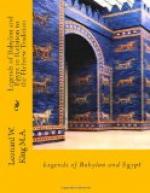There are three pre-exilic periods at which it has been suggested the Hebrews, or the ancestors of the race, may have acquired a knowledge of Babylonian traditions. The earliest of these is the age of the patriarchs, the traditional ancestors of the Hebrew nation. The second period is that of the settlement in Canaan, which we may put from 1200 B.C. to the establishment of David’s kingdom at about 1000 B.C. The third period is that of the later Judaean monarch, from 734 B.C. to 586 B.C., the date of the fall of Jerusalem; and in this last period there are two reigns of special importance in this connexion, those of Ahaz (734-720 B.C.) and Manasseh (693-638 B.C.).
With regard to the earliest of these periods, those who support the Mosaic authorship of the Pentateuch may quite consistently assume that Abraham heard the legends in Ur of the Chaldees. And a simple retention of the traditional view seems to me a far preferable attitude to any elaborate attempt at rationalizing it. It is admitted that Arabia was the cradle of the Semitic race; and the most natural line of advance from Arabia to Aram and thence to Palestine would be up the Euphrates Valley. Some writers therefore assume that nomad tribes, personified in the traditional figure of Abraham, may have camped for a time in the neighbourhood of Ur and Babylon; and that they may have carried the Babylonian stories with them in their wanderings, and continued to preserve them during their long subsequent history. But, even granting that such nomads would have taken any interest in traditions of settled folk, this view hardly commends itself. For stories received from foreign sources become more and more transformed in the course of centuries.(1) The vivid Babylonian colouring of the Genesis narratives cannot be reconciled with this explanation of their source.
(1) This objection would not of course apply to M. Naville’s suggested solution, that cuneiform tablets formed the medium of transmission. But its author himself adds that he does not deny its conjectural character; see The Text of the Old Testament (Schweich Lectures, 1915), p. 32.
A far greater number of writers hold that it was after their arrival in Palestine that the Hebrew patriarchs came into contact with Babylonian culture. It is true that from an early period Syria was the scene of Babylonian invasions, and in the first lecture we noted some newly recovered evidence upon this point. Moreover, the dynasty to which Hammurabi belonged came originally from the north-eastern border of Canaan and Hammurabi himself exercised authority in the west. Thus a plausible case could be made out by exponents of this theory, especially as many parallels were noted between the Mosaic legislation and that contained in Hammurabi’s Code. But it is now generally recognized that the features common to both the Hebrew and the Babylonian legal systems may be paralleled to-day in the Semitic East and elsewhere,(1) and cannot




